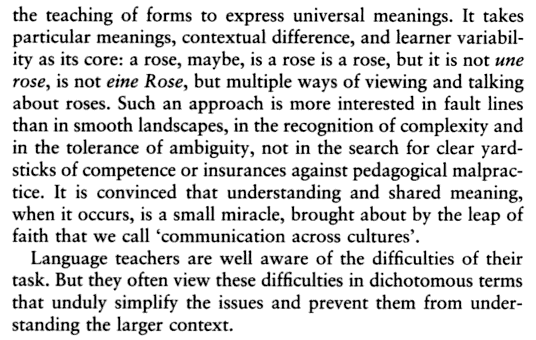Author: gabiguillen
L2 Writing Assignments: Add value
“When students perceived they were contributing something of value to the public arena, they put in a great deal of effort in the process and attention to the product, yielding positive results in their learning to write in a second language. When students did not see their work as having any particular social or cultural relevance, they showed little interest in Web-based publishing and the medium itself lent little extra legitimacy or authenticity to their writing assignments.” (Warshauer 1998:64)
Language Teaching: The Need of Conflict
As language teachers, simplifying grammar or culture is tempting. However, learning a second language is not easy nor simple. It takes not only effort but empathy and tolerance of ambiguity. In 1993, Claire Krasmch proposed a conflict approach. The philosophy of conflict does not imply to avoid scaffolding but, precisely, to prepare students for the linguistic and (inter)cultural blurriness of any L2.
So next time you teach, ask yourself. Is this scaffolding or saving face time?
Here is an extract from her book, Context and Culture (p. 2). 
Recommendations for improving research in SLA
From Norris & Ortega (2000, pp. 497-498). [bold emphasis is mine]
- Utilize simple designs that investigate only a few variables at most; interactions of variables should be investigated systematically across multiple experiments, not within single experiments.
- Incorporate pre-tests and post-tests as well as true control groups in experimental and quasi-experimental study designs, to identify better the amount of observed effects attributable to instructional treatments.
- Design studies with the replication of variables (not other studies) in mind; avoid the myth of the single decisive study by engaging in long-term research agendas in which a series of studies systematically provides data points about specific variables.
- Consider the validity of dependent variables in terms of the kinds of interpretations to be based on them; estimate and report the consistency or reliability of the use of outcome measures.
- Choose the analytic and interpretive techniques that will provide accurate answers to the research questions that are being asked; where used, interpret results of statistical significance tests appropriately.
- For questions about the presence of an effect, the size of an effect, or the importance of an effect, calculate effect sizes (statistical significance tests will not provide answers to any of these questions).
- Incorporate estimates of error (e.g., standard error, confidence intervals) into all quantitative analyses of experimental data.
- Report enough data about independent, dependent, and moderator variables such that related findings may be compared with other investigations of the same variables and such that future researchers will be able to replicate these variables; include observations about what actually occurred when variables were operationalized in investigations.
- Always report the data necessary to enable further interpretation and accumulation of study findings, including, but not limited to: means, standard deviations, and group sample sizes on all pre- and post-experimental measures (regardless of statistical significance); where used, report complete results of statistical significance tests (e.g., not just the probability levels or F or t values for findings that were observed to be statistically significant).
He aprovechado un descanso en mis estudios para compartir las recomendaciones de Norris & Ortega (2000, pp. 497-498) en el campo de la investigación cuantitativa en Adquisición de Segundas Lenguas. Por razones obvias, pese a ser más denso que el dulce de leche, es el artículo más citado de la revista Language Learning.
Soy algo escéptico con el uso de la significación estadística en la investigación del aprendizaje de segundas lenguas. El artículo en cuestión confirma mis sospechas: resulta complicado generalizar, sobre todo si no se tiene en cuenta el tamaño del efecto (effect size). En todo caso, entiendo la moda y la necesidad de los estudios cuantitativos.
De hecho, aunque el número de participantes para mis experimentos va a ser limitado (50 participantes, aproximadamente), voy a combinar métodos cualitativos y cuantitativos, teniendo en cuenta las recomendaciones y los ejemplos que proponen Norris & Ortega para los últimos. Ni que decir tiene que intentaré seguir un rigor paralelo, si no mayor, en el estudio cualitativo.
Por cierto, uno de los muchos “bonus” del artículo es una jerarquía de efectividad en la instrucción de segundas lenguas:
Focus on Form explicit > Focus on Forms explicit > Focus on Form implicit > Focus on Forms implicit
Self-evaluate your language skills
“Este programa te ayudará a evaluar tu nivel de competencia en las lenguas que sabes de acuerdo con seis niveles de referencia definidos en el Marco Común Europeo de Referencia para las Lenguas (MCERL). La escala de referencia, creada por el Consejo de Europa en 2001 es reconocida como un sistema estándar europeo para evaluar la competencia lingüística de cada individuo y es empleado por sistemas educativos nacionales, organismos certificadores y empleadores. Cuando respondas a las preguntas recuerda que se trata tan solo de un procedimiento de auto-evaluación y que los resultados solamente reflejan parte de tus destrezas, ¡es sólo un juego! Solo tú sabes hasta donde llegan realmente tus habilidades” (Consejo de Europa)
